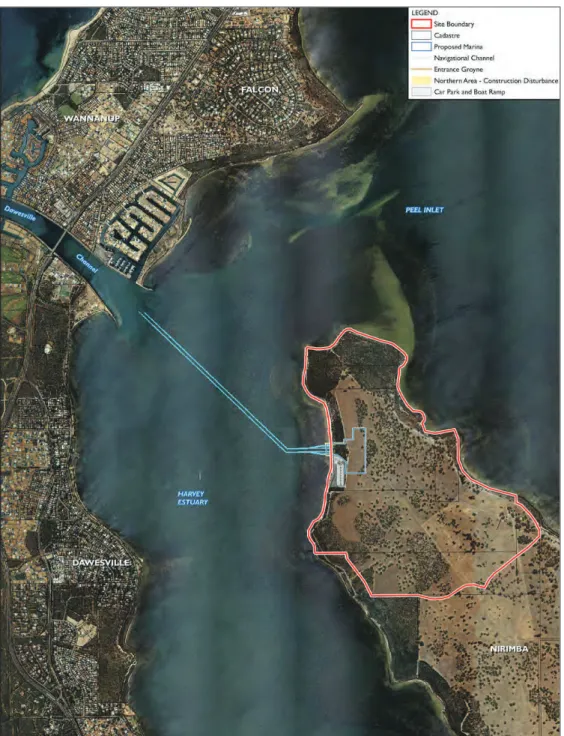Short-term ecological objectives in place for each component of fine fisheries in PHE. Short-term ecological targets in place for each component of the blue swimmer crab fishery in PHE.
Aquatic Environment
Target Species / Stock Description
Sea Mullet
The reproductive cycle of blue swimmer crab populations along the WA coast is strongly influenced by water temperature (de Lestang et al. 2010). Blue swimmer crabs in WA can grow to a maximum size of about 200 mm CW (de Lestang et al. 2003c).

Commercial Fishing Activities
The majority (63%) of the annual commercial catch of blue swimmer crabs in WCEMF Area 2 is typically taken during the summer months, i.e. gillnets used primarily by shore-based recreational fishers in the PHE to target blue swimming crabs (Photo: Alastair Harry [DoF] 2014).
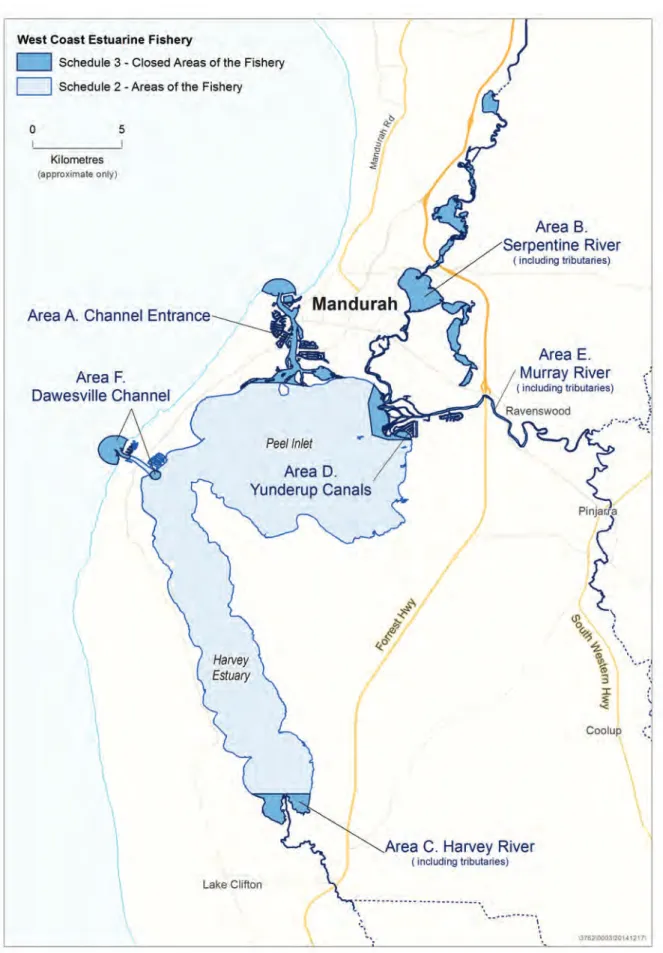
Commercial Management System
A summary of specific fisheries governance and management related to WCEMF area 2 and the Peel-Harvey Estuary Blue Swimmer Crab Recreational Fishery is presented below. As also described in the FRMR, commercial fishermen must comply with a minimum size limit of 127 mm CW for blue swimmer crabs caught in the PHE.
Integrated Fisheries Management (IFM)
Environmental Management under the Ramsar Convention
As a signatory to the Ramsar Convention, the Australian Government has responsibilities to maintain listed wetlands. The Peel-Yalgorup System Ramsar Site Management Plan (PHCC 2009) was developed as a practical site-specific application of the Ramsar's "wise use" principles.
Catch from Other Fisheries
The main external influences associated with fishing in PHE are (1) bycatch of target stocks by other fisheries, (2) market influences, (3) environmental factors, and (4) urban and other developments. Retained catches (in tonnes, t) of blue swimming crabs from other commercial fisheries in SW WA targeting the same stock as that in WCEMF Area 2.
Environmental Influences
Since the opening of the waterway, the composition of the fishing communities in the different regions has become more similar. Changes in flows and transfer efficiency illustrate a change in ecosystem function since the opening of the Dawesville Channel (Fretzer 2011).
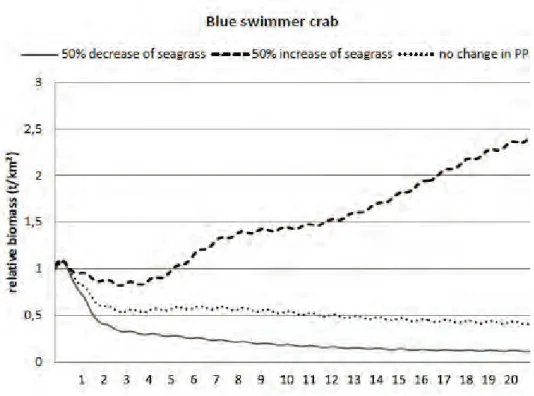
Stock Status
- Current Stock Status
- Assessment Description
- Assessment Approach
- Uncertainty in the Assessment
- Evaluation of Assessment
- Peer Review of Assessment
Annual standardized commercial catch rate (kg/100 m net-hours) of sea mullet in WCEMF area 2 relative to associated reference points. Annual commercial catch (tonnes) of sea mullet in WCEMF area 2 relative to associated reference points. Annual commercial catch (tons) of blue swimmer crabs in WCEMF Area 2 relative to associated reference points.
The standardized annual catch rate (± 95% CI) of sea mullet in WCEMF Area 2 is shown in Figure 7.2. ANOVA (type I and type III sum of squares, SS) table for the fitted model used to describe the monthly catch rate of blue swimmer crabs in WCEMF Area 2.
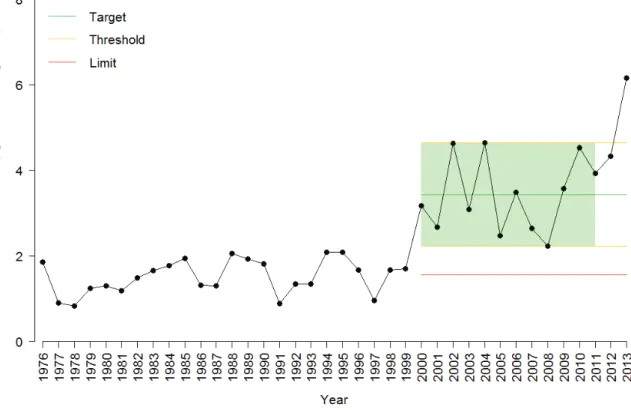
Harvest Strategy
Framework
The harvest control rules for red mullet and blue swimmer crabs in the PGO are appropriate and effective to control the exploitation of the breeding stock. Summary of available information to support red mullet harvesting strategy in the PGO. Summary of available information to support blue swimmer crab harvesting strategy in the PGO.
The monthly commercial catch and effort data for mullet and blue swimmer crabs in the. Summaries of commercial catch and effort trends in the WCEMF Area 2 for sea urchins and blue swimmer crabs are provided in Section 3.1.4.
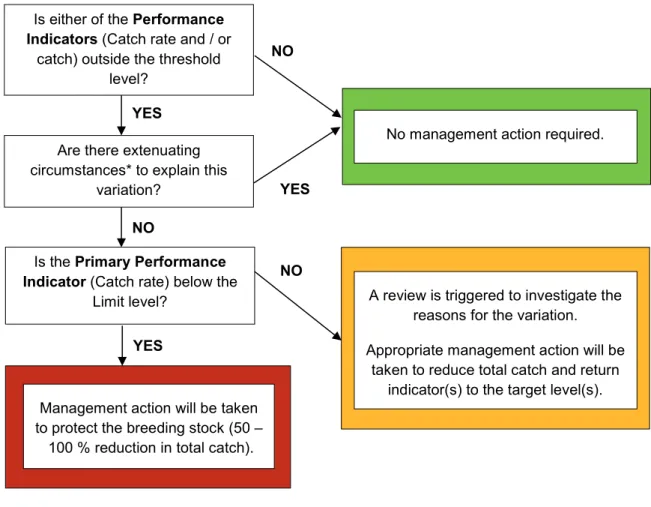
Fishery Impacts
Risk Assessments
In addition, the location of commercial fishing activities relative to benthic habitats in the estuary is relatively unknown, as all commercial fishing activities occur within a single reporting block on the Catch and Effort Data (CAES). Note that fishery distribution information is available through commercial blue swimmer crab monitoring conducted annually by the Ministry's Research Department.). Due to the lack of quantitative information, an internal risk assessment was performed on benthic habitats for WCEMF Area 2 in January 2015 using both SICA and CSA methodologies. Using the SICA methodology, all fishing methods in the PGO scored a Consequence Category 1, which has an MSC equivalent score of 100.
Retained (Non-Target) Species
Mullet and yelloweye mullet are the main bait species used by trappers in WCEMF Area 2. Blue swimmer crabs are the target species for over 90% of recreational anglers in the PHE (Malseed & Sumner 2001). Sample of bait species and quantity used (number) by recreational drop net fishermen in PHE.
This project provided valuable information on the amount and composition of bycatch in the WCEMF area 2 (haul) net sector. No information is currently available on the level of interactions with ETP species by recreational blue swimmer crab fishermen in the PHE.
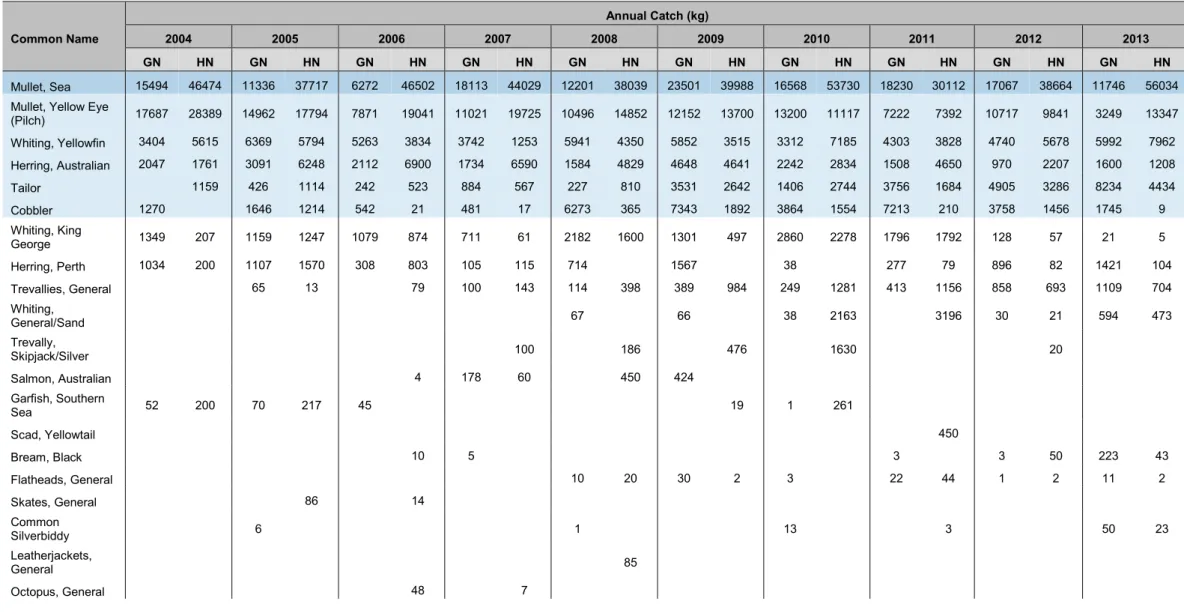
Habitats
Sea grass and macroalgae are distributed throughout the estuary, with seasonal variations in biomass due to the ephemeral nature of the estuary. Seagrass and macroalgae habitats are scattered throughout the estuary, with seasonal changes in biomass due to the ephemeral nature of the estuary. Recreational blue swimmer crab nets are primarily set from boats in the deeper water areas of the estuary.
In addition, the nets are unlikely to be dragged along the bottom during hauling due to the shallow nature of the estuary. Eelgrass and macroalgae occur throughout the PGO, with seasonal changes in biomass due to the estuary nature of the estuary.
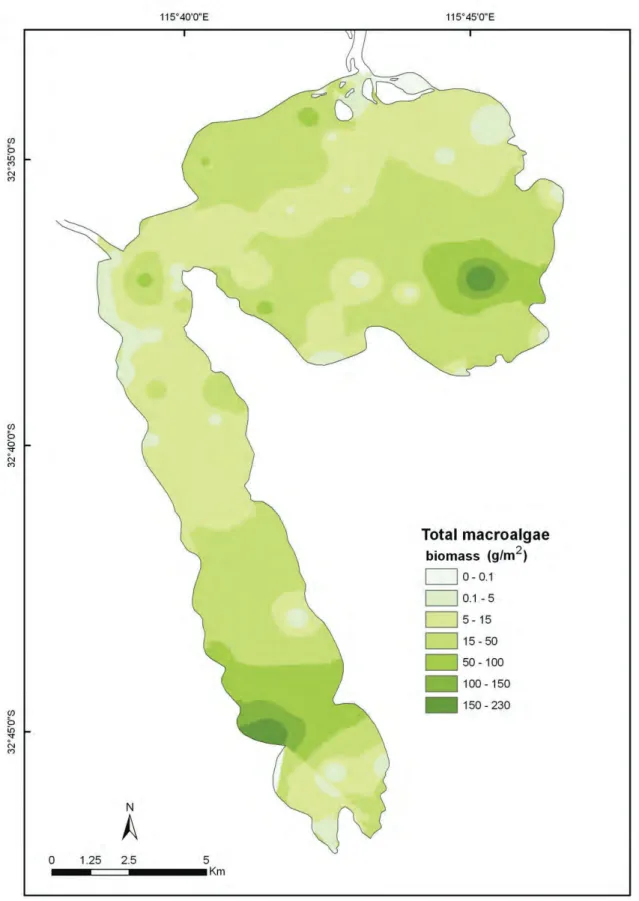
Commercial Net and Trap Fisheries
Similarly, Shester and Micheli (2011) studied the impacts of lobster traps on rocky reef and temperate algal forest habitats consisting of large gorgonian corals and southern sea palms (Eisenia arborea) in Mexico. Initial attempts to place traps on Eisenia showed that this habitat can withstand the force of the trap's fall. Therefore, the effects of falling traps on gorgonian corals were studied as "worst case scenario" effects.
Dropping traps appeared to have minimal effect on gorgonian corals, while dragging traps to the seafloor resulted in more coral damage, although this damage was still small (< 5% of the skeleton). Fishing strategies for finfish and bluefin resources in the PHE include both long-term and operational objectives for each ecosystem component (see Principle 3 - Section 13.2).
Recreational Drop and Scoop Net Fisheries
There are also daily bag limits for a number of finfish species that can be caught by recreational blue swimmer crab fishermen in the estuary. Within WA, daily bag limits are set for mixed species of small fish based on their aquatic environment (ie, submersible, pelagic, nearshore / estuarine or freshwater) and for individual species. There is a mixed daily bag limit of 30 fish per angler of combined Australian herring, bream (excluding King George cage) and snapper.
Tailors have an individual daily bag limit of four and a combined mixed species daily bag limit of 16 (in combination with other inshore/estuarine finfish) per Fisherman. Daily bag and boat limits also apply to invertebrates such as clams and rock lobsters (DoF 2014a).
Information and Monitoring
Commercial Net and Trap Fisheries
Some information on bycatch composition in the gillnet sector (gillnets only) is available from a bycatch observer program that took place in March 2015 (see Section 9.3.1).
Recreational Drop and Scoop Net Fisheries
The information provided by the fishermen is considered to be sufficient to assess and evaluate the status of the result for all components and to support the management measures in force. Sufficient data continue to be collected to detect any increase in risk for each component and to estimate ongoing mortalities of all stocked species. As the primary impact of the recreational blue swimmer crab fishery is the removal of blue swimmer crabs from the estuary, this information is considered sufficient to allow the determination of the main ecosystem consequences of recreational blue swimmer crab fishing activities.
In this context, fisheries must demonstrate compliance with all local, national and international laws and have a management system in place to respond to changing circumstances and maintain sustainability (MSC 2013).
Governance and Policy
Legal and / or Customary Framework
Under the FRMA there is a division of powers between the Minister of Fisheries and the statutory office of the Department's CEO. Aquatic Biodiversity Policy — The Department is currently drafting an overarching policy that describes the Department's role, responsibilities and jurisdiction in the management of the State's aquatic biodiversity. The members of the Department's Corporate Management and an organizational chart are published in the Department's Annual Report.
Providing feedback to the Department on proposed deliverables and budget priorities for expenditure from the Fisheries Research and Development Account;. The Internal Audit Committee maintains and manages the Department's internal audit function on behalf of the DG.
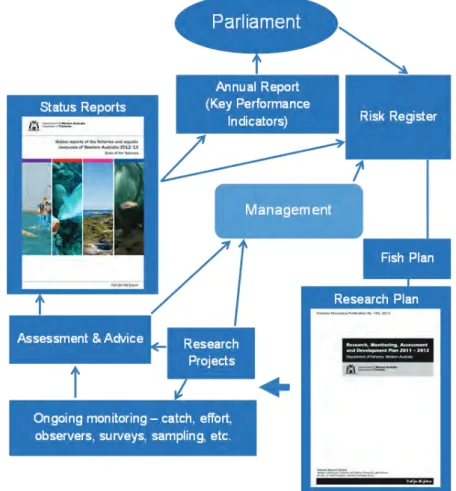
Incentives for Sustainable Fishing
The Committee assists the Directorate General in identifying and quantifying risks that could hinder the Ministry in achieving its goals, and in directing the development and implementation of risk mitigation strategies. Ad hoc research, management and compliance meetings during the season with licensees and other stakeholders;. A wide range of policy, research, governance, education, compliance and other publications on the Ministry's website;.
Compliance, research and management staff work together to monitor compliance with sustainable fisheries agreements, and the Department actively considers and reviews management policies and procedures to ensure they do not contribute to unsustainable fishing practices and will adjust fishing arrangements if necessary. There are no incentives for fishermen to fish unsustainably and community pressure to 'do the right thing' leads to a high level of compliance and community members report fishermen seen fishing illegally to the Department or through Fishwatch.
Fishery-Specific Management System
Harvest Strategy
Fishery-Specific Objectives
As fully described in the harvest strategies for PHE's minnow and blue swimming crab resources (see DoF 2015a, b), the social and economic objectives for these fisheries relate to providing opportunities to ensure (1) commercial fishermen can maximize their livelihood in supplying the community with seafood and (2) that all fishermen can maximize culture,. An example of this can be seen in the recent closure of the Cockburn Sound bluefin crab fishery (see section 13.3.1). A summary of the control measures in place in the WCEMF and the Peel-Harvey Estuary Blue Swimmer Crab Recreational Fishery are provided in Table 13.5 and Table 13.6, respectively.
Comparison of contact rates for recreational fishing compliance in the PHE at different times of the day over three different time periods. 107 (blue swimming crabs) determined the size of the recreational boat-based catch on the West Coast.
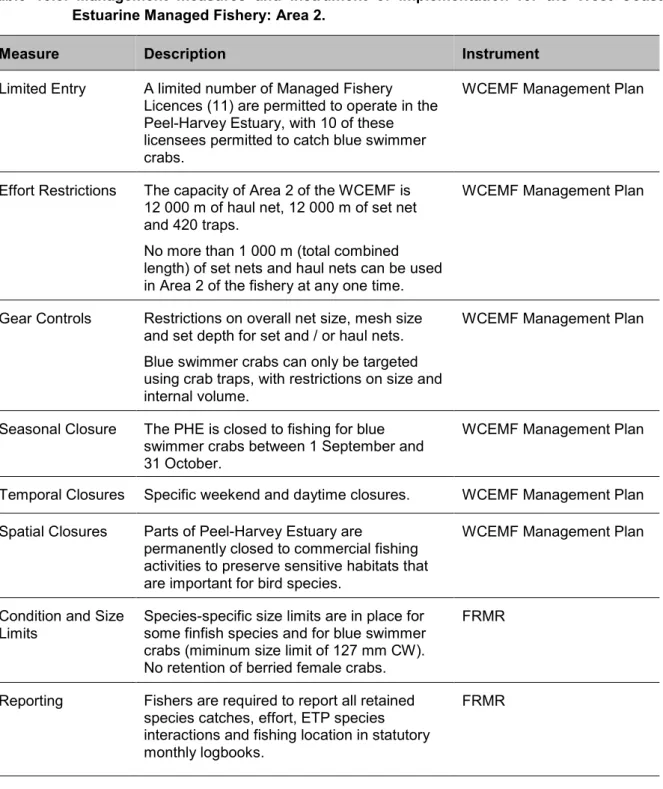
Monitoring and Management Performance Evaluation
General References (Sections 1 – 5)
MSC Principle 1 References (Sections 6 – 8)
MSC Principle 2 References (Sections 9 – 11)
MSC Principle 3 References (Sections 12 – 13)
Appendices
Additional References Provided to Assessment Team
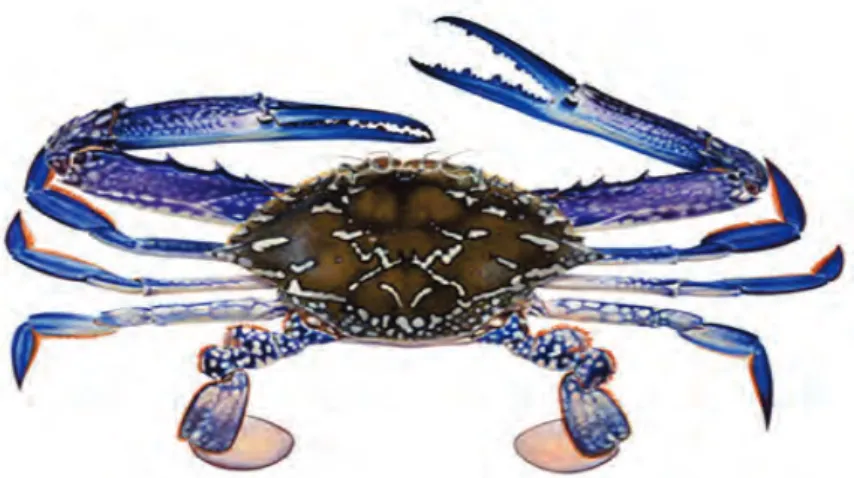
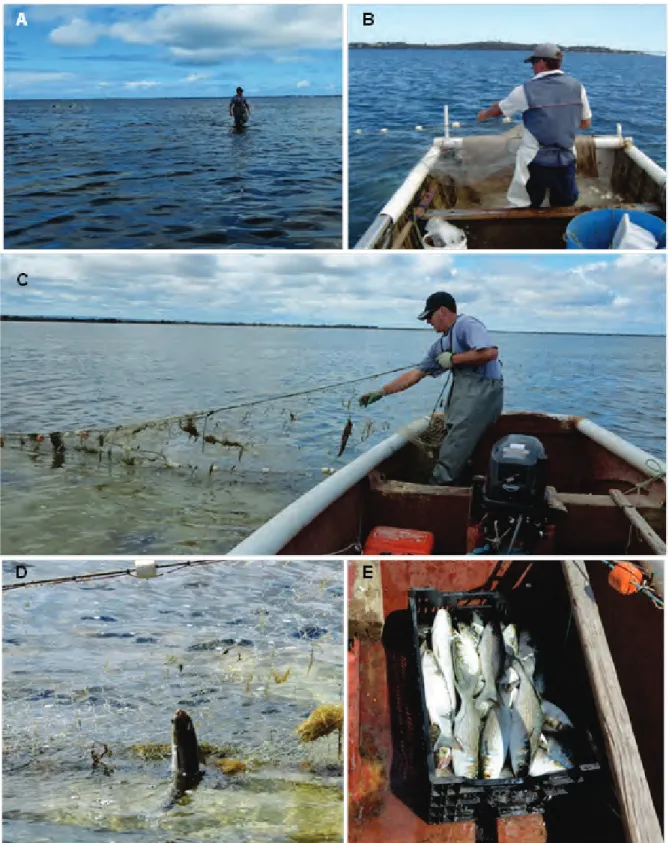
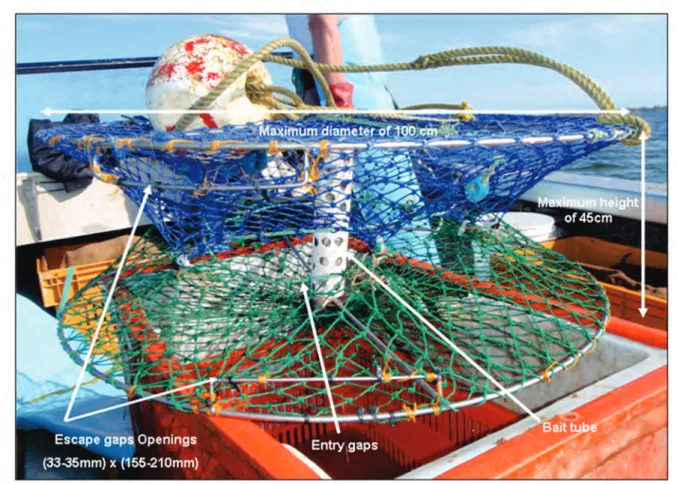
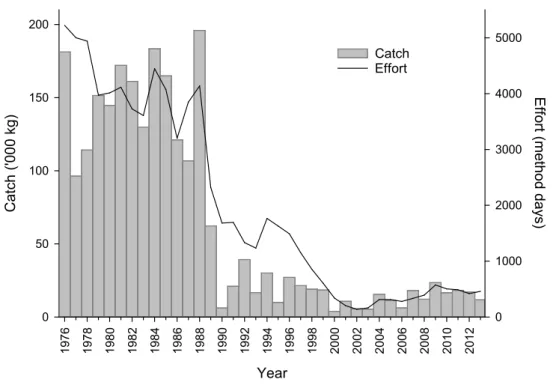
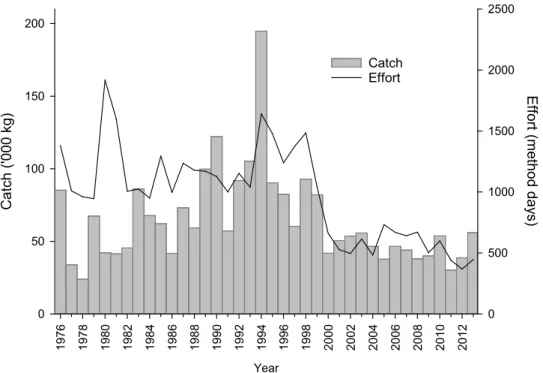
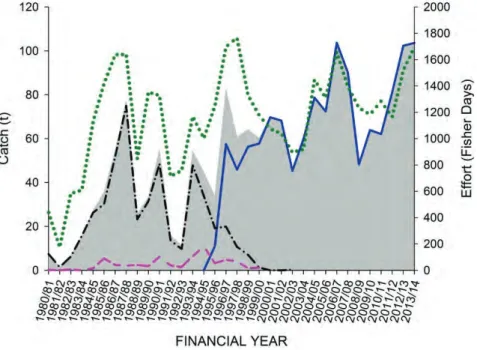
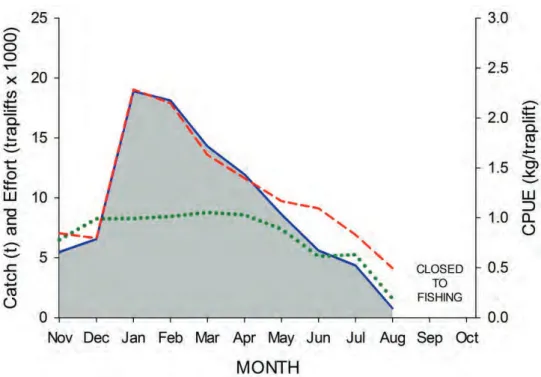
![Figure 3.15. Scoop net used primarily by shore-based recreational fishers in the PHE to target blue swimmer crabs (Photo: Alastair Harry [DoF] 2014)](https://thumb-ap.123doks.com/thumbv2/5docco/10302130.0/49.892.190.698.188.647/figure-scoop-primarily-recreational-fishers-target-swimmer-alastair.webp)
